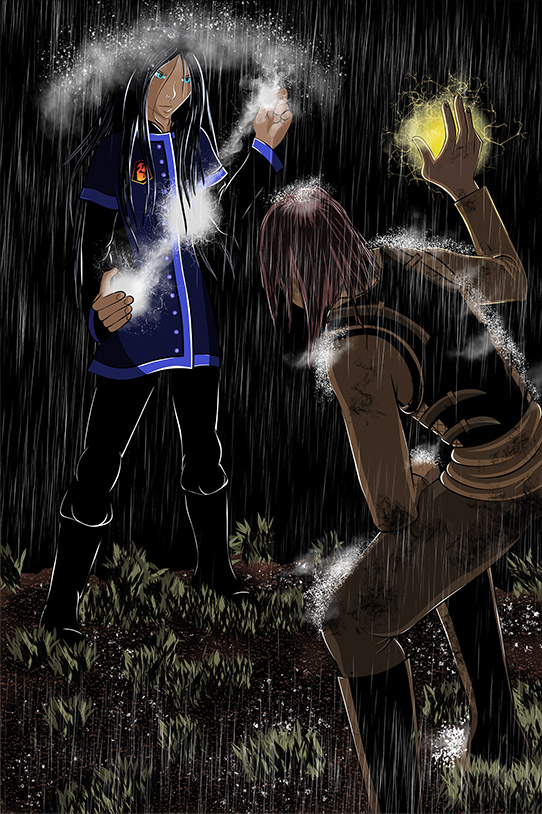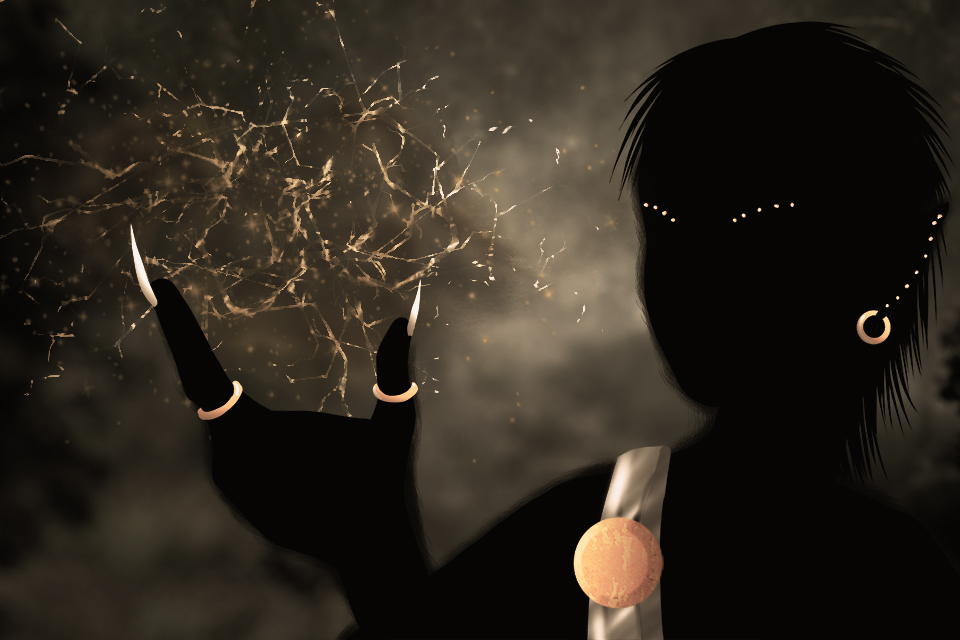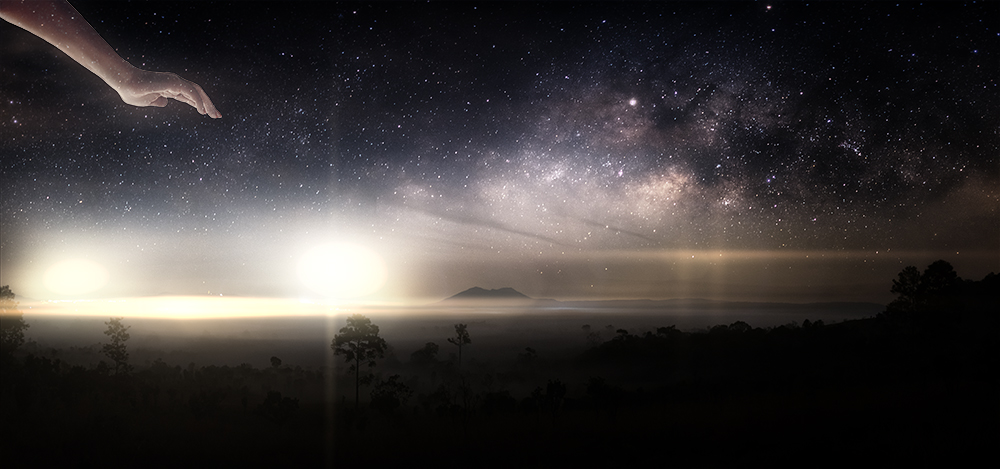Magick on Seari
To wield is to hold the potential of the unkown in your hands. All acts are exploration, all mistakes an opportunity to delve into a mystery.
Once harnessed, wielding becomes our way to glimpse the awe and nature of creation.
In this document:
All artwork by Shade Melodique unless otherwise stated
Magick is an everyday tool on Seari, used for mundane things such as lighting a room to powerful offensive magicks used to destroy cities. Nearly 11% of the total population are born to wield magick, but almost half of them do not have much power or ability. Those who do tend to work for royalty, nobles, and lead religious cults.
Anyone who can afford the tuition attends a school that specializes in teaching the mystery arts. Schools range from general instruction, where the majority of students become hearth practitioners, to expensive academies, where children from wealthy families have a more intense and focused study, choosing to concentrate on specific fields such as war magicks or healing. Post-schooling study takes place through cooperatives or is done independently, though a few schools, such as the Palace School in Iova, have specialized research led by a genophyte who employs other genophytes and acophytes to conduct the inquiries.
Many schools owe their existence to famous and powerful mystery artists, who found they attracted too many pupils to comfortably tutor them individually. Condioh has the distinction of housing most of the elite academies for mystery artists who practice the lightarts, with Rikondi a close second. The Palace School in Iova is widely recognized as producing the most scholarly shadowartists, while Shayd, the capital of Illena, houses the majority of elite shadowarts academies, with Shalradioh in Oritan and Clandestine in Verad close behind. Rakan, Teral and Baq do not have large academies, but smaller regional schools that produce some of the most powerful shadowartists in Seari.
Hearth practitioners are the most common users of magick. Hearth magics include simple spells like creating a bauble of light to complex wieldings that keep gardens in a state of green year-round. Most healers are hearth wielders without the grand power, so are experts in polstices, casts, salves, and potions.
Types of Magick
On Seari, magick is divided into nine subtypes, which are associated with the Nine Abysses. They are normally referenced using native languages, but elite academies only use the Daione terms to refer to magick and their associated Abysses.
The subtypes' association with the Abysses is an ancient view first defined by dragons. As with most things dragon-related, how they thought of things is considered an important tradition, with little to no tampering tolerated. Most academics tend to cough and ignore the fact that modern magickal thought, including colors associated with each subtype, is centered in Ga Iniria assumptions concerning magick, even if they used the dragon traditions as a base.
The subtypes of magick
- Earth:
earth, hearth, defensive magicks. - Greenroot
healing, farming, natural world, life and death - Water
water, fluids, rain, bloodarts, destruction - Ice
ice, cold, snow, offensive magicks - Fire
fire, heat, offensive magicks - Air
wind, weather, offensive magicks - Mystery Arts
mystery arts, defensive magicks, enchantments - Light
lightarts, illumination, holy magick, enchantments - Dark
dark arts, shadowarts, twilight, conjuration
There are six divisions of human mystery artists on Seari.
Bloodmages
Conjurers
Healers
Hearthartists
Lightartists
Shadowartists
The Jonna Empire siojhetioxh cemented these divisions. For these lightartists, shadowartists were enemy #1. They saw them as warping Light's intended role as holy magick, and killed practitioners accordingly. The resentment and animosity still simmer below the surface, and are especially pointed in clashes between Condi siojhetioxh and aki n'di ori shadowartists.
In general, all artists "wield" spells except for conjurers, who "cast" spells.
Twilight beings have their own titles for mystery artists; dragons and sylfaodolon tend to align more closely with an Abyss, though dragon ability to wield varied spells outstrips sylfaodolon due to sylf natures (see below).
Of Note:
- Healing was once considered a bloodart, but after the bloodarts became closely entwined with bloodsylf adherents, healing became associated with greenroot wieldings. The more powerful healing spells, however, have their base in the bloodarts
- Dark spells were historically the purview of the inhabitants of the twilight realm (the remains of the first world Aseris created). Descendents of the Condi lumped conjuration and the shadowarts into this category to make a moral judgment on their use in the sunlit realm. While modern practitioners still use this delineation, the morality of dark spells is no longer an issue.
- Mystery arts is the catch-all category. Most new spells and theories are shoved here, until they can find a proper place
- Mixing spells from the subtypes is done often, and with relish, by the shadowartists. Light artists tend to follow a strict set of wieldings, done in the same way, and never altered. This means more unique magickal research is conducted by shadowartists
Spells are typically placed within a subtype depending on its purpose, not necessarily the underlying spells combining to create it.
For instance, fire spells are associated with fire (burning flames), but also ice (burning cold flames), light (heat and light flames), dark (offensive magick flames), earth (volcanic flames). All of these have a simple greenroot (hearth-related) fire spell as the base.
All subtypes have offensive, defensive, and common spells. Advanced wieldings incorporate more than one subtype within a single spell, though, as with most things magick, the Condi are particular about what group of spells can officially be considered Light-oriented. Religious institutions tend to side with them, and most wielders let them do as they wish.
Magickal Natures
Magickal natures are very important to the practice of the mystery arts. Wielders favor some spells over others, or simply find using them easier, and develop an affinity for those magicks. They can more effectively wield them, as well as combine them with other types of magick to create unique and powerful spells. Unfortunately, affinities can lead to the development of weaknesses, such as a flame wielder unable to tolerate or counteract ice spells, which rivals and enemies can exploit. This is part of the reason that nobles and royalty keep the exact power and abilities of their most trusted mystery artists in close confidence; exploitations at the wrong time could end in their deaths. Elite mystery artists study to prevent succumbing to such vulnerabilities, and most academies dissuade favoring one magick over another. Still, even the strongest mystery artist can have a weakness. To overcome their lack, many own magickal items that do what they cannot. These items are talismans, amulets, wands and staves (or whatever shiny thing appeals to the artist), and contain select spells. An expert in flame wieldings might carry an amulet for protection against ice-related spells, or one that allows them to throw iceballs at an opponent. Most often, these items are used for defensive shielding. While useful, items are notorious for depleting quickly, and take an age to recharge (unlike mystery artists, who can tap into the Abysses and use their energy to refill their magickal resources). This makes them a less-than-ideal alternative to magick know-how.
Imps are a favorite summoning target of conjurers. They are intelligent, sophisticated wielders, and conjurers, if they capture the right Imp, can have a strong magick user who has no choice but to do their bidding. Because of this, Imp research into combating summoning is a high priority of their mystery arts academies.
Twilight Magick
Searan magick is based on the way dragons viewed the mystery arts and their connection to the Abysses. Twilight beings and sylfaodolon have the same base to work with (the Abysses have a magickal lean, magick is instictively recharged from the Abysses) but view wieldings in a different light. Because Twilight is the shadowy demesne of the Dark sylf, Ceaque, light has a different meaning there. Bright jewelry and clothing that contrasts with the shadows are more along the 'Light' they refer to. They have different interpretations of other magickal leanings because every twilight living creature is born with instinctual magick, from insects to giants. In this respect, magick works differently there. Few on Seari would give this much thought, except mystery artists summon beings and creatures from Twilight. Understanding the clash between instinctual magick and sunlit realm magick is important, if a conjurer wants to keep the creature they conjured alive. And if wielders need to take care of a creature that is running amok, they also need to understand the basics of instinctual magick or their riding to the rescue might end up with their death.
Sylfaodolon have abilities beyond mortal wielders (though dragons will vehemently disagree).
One of the more potent magicks is sylf splendor. A sylfaone who wishes to instill awe in followers (not that they are not already awed, but because sylf are vain), will initiate a splendor spell. They glow with heavenly light, their voice is loud enough to deafen, and the suffocating feel of Arberiss weighs upon the mortals.
Sylf splendor terrifies humans. Dragons find it annoying.
Sylfaodolon Natures
Natures are especially important to sylfaodolon, who are wedded to their magicks and cannot deviate from them without causing themselves harm. This makes them very susceptible to magick that is opposite their nature, e.g., a snow deity cannot wield fire—though, if the sylfaone is crafty enough, they can weasel around the restrictions. This malleability allows deities to change their nature when another one calls to them, though it is rare for them to accept a magick completely opposite their original nature. Sylfaodolon natures only refer to their magickal abilities; for instance, a sylfaone of deep freezes can still feel the flame of passion for a love interest and eat hot soup. It is true, however, that some sylfaodolon develop reactions akin to allergies to natural settings that are against their nature. This difficulty is mental but manifests magickally. As expected, sylfaodolon have far more power and intricate spell knowledge than mortals, but they also have more restrictions upon their use. Horrific sylf abuse of magick destroyed the first sphere Aseris and her companions created, and she refused to see the same happen to her second. And, as expected, humans are not privy to the exact content of these restrictions. This provides the deities with an excuse as to why they have not answered prayers with divine wieldings, and gives religious leaders a way to explain why sylf interference has not materialized on their cult's behalf.Untidy Magick
Despite scholarly insistence on neat boxes and everything in its correct place, magick is not a tidy discipline easily defined. Numerous practitioners use more than one type of magick, such as mystery artists using hearth magick to alter their appearance when their primary abilities lie in the shadowarts or the lightarts. There are numerous wieldings that any magick user with enough knowledge or power can utilize, such as the creation of light. Light technically falls within the purview of the heartharts, but every type of wielder or caster can create it, oftentimes with a slight difference that makes it a light wielding, or a shadow wielding. These differences are hotly contested, as to whether they make the spell distinctive enough to call it a light or shadow wielding, rather than a hearth one. In an attempt to avoid conflict and confusion, some scholars and practitioners lump everything that might cause genre difficulties into the broadly defined "mystery arts" category. This hardly solves the arguments, and it makes that particular subtype bloated with random wieldings and castings that have no similarity to each other than, "We don't know where to put this." In some circles, this is intentional, especially among lightartists, who prefer regimented wieldings wielded in exactly the same way by everyone who uses it. It is a way to counter the ingenuity of shadowartists, who rarely care from which type of magick they draw, as long as the wielding works as expected.
Shadowartists are reknown for their ingenious manipulation of magick, and none more so than the aki n'di ori artists. Their lack of fear of the power of Condi siojhetioxh stems from this; they know, when confronted with a lightartist, they have better than even odds of winning by stepping outside the strictures of prescribed spells.
This has not stopped strong lightartists from hunting down powerful shadowartists, but times have changed since the Jonna Empire. Countries are not supportive of these efforts, since the majority of their strong wielders are shadowartists and citizens tend to get caught in the middle of conflicts.
At various points in history, the general populace sided with the holy lightartists against outsiders, but the awe now








Comments